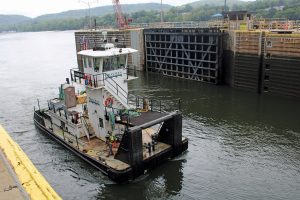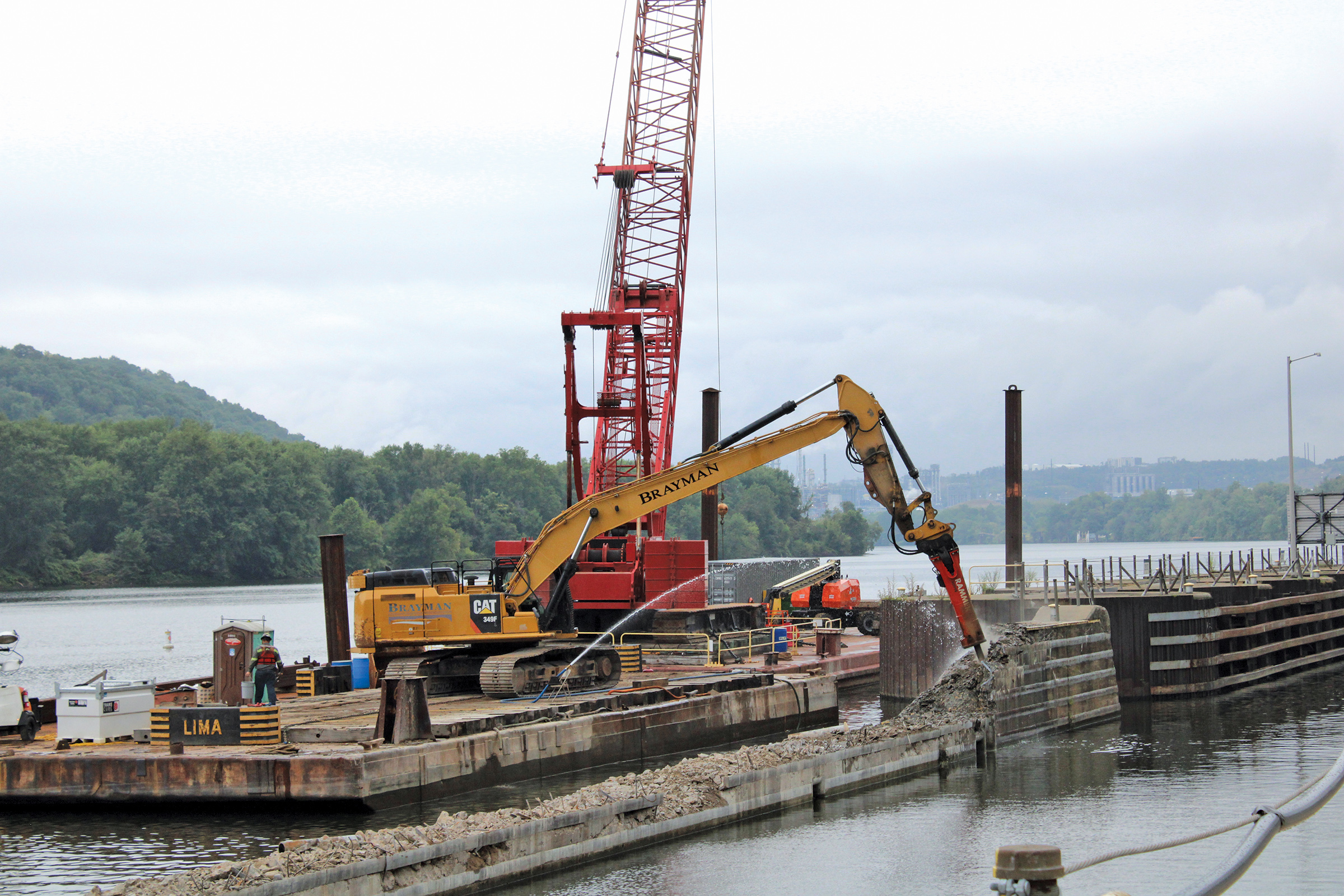Construction on a new main lock chamber over the footprint of the existing auxiliary chamber at Montgomery Locks and Dam is designed to reduce lock transit delays and increase safety.
The work on the new, 600-foot-long, 110-foot-wide chamber at Ohio River Mile 31.7 in Monaca, Penn., is under construction while the existing same-sized main chamber remains open to navigation. The auxiliary chamber, which is 300 feet long and 56 feet wide, closed in March.
While 600-foot chambers can hold a nine-barge tow, which is standard for the region, the smaller chamber could fit only one barge at a time. That meant it could take nine hours or longer for one tow to lock through, costing time and money for those using the waterway.
Crews have fully mobilized within the past month to demolish the old auxiliary lock in preparation for building the new, larger lock chamber. They are using heavy equipment to chip away at the concrete approach guidewalls for the old chamber along with explosive blasts. Besides demolition, crews are also stabilizing nearby concrete monoliths along the middle wall, between the existing main chamber and the new chamber. Work also continues on a batch concrete plant at the site that will be used to place concrete for new lock monoliths.
Pittsburgh Engineer District employees allowed visiting members of the media and regional stakeholders to tour the lock construction project August 20 as part of an annual media tour sponsored by Waterways Council Inc. The annual WCI tour highlights a lock construction project each year so that reporters can better understand what it takes to build a megaproject on the inland waterways system and why it is important to recapitalize antiquated lock structures, WCI Senior Vice President Deb Calhoun said.
The construction project at Montgomery Locks and Dam is incredibly complex and requires precision, said Col. Nicholas Melin, commander of the Pittsburgh Engineer District. He compared it to building a five-story building upside down into the bed of the Ohio River, all while maintaining navigation in the adjacent lock just a few feet away.
Melin called the locks, situated northwest of Pittsburgh, critical to region’s economy.
“This is really the gateway to the Port of Pittsburgh, so if you think about all the industry around the Pittsburgh waterfront and then up the Monongahela, U.S. Steel, the Clairton Coke Works, all of the great industry this region is known for, these lock chambers allow materials that are needed for that industry to pass up and down this river, and this is by far the most efficient and cost-effective way to transport it,” he said.
Port of Pittsburgh Commission Executive Director Mary Ann Bucci noted that the port is the fourth largest inland waterways port in the nation.
The work being completed at Montgomery is an integral part of the Upper Ohio Navigation Project, which eventually will also involve enlarging auxiliary locks at Emsworth and Dashields locks and dams. The three locks are the oldest and smallest on the Ohio River.
“When I say smallest, that means everything downstream from here is twice as big,” said Chris Dening, project manager at the Montgomery site. “They have a 1,200-foot capacity. This only has a 600-foot, so it becomes kind of a natural bottleneck for industry when they are coming up toward the Port of Pittsburgh.”
Montgomery Locks and Dam was built between 1932 and 1936, replacing three older-style wooden wicket dams. The locks were rehabilitated in the 1980s in

order to extend their design life by another 25 years, Dening said.
“It’s getting pretty important for us to recapitalize these pieces of infrastructure,” he said.
Beginning the work now and funding it to completion is important, he said, as without that, “It really deteriorates our ability to guarantee navigation. Eventually these structures will fail, and we’d have to do emergency shutdowns.”
The economic impact of a one-year closure at Montgomery Locks and Dam would cost the United States nearly $150 million, the Corps of Engineers said late last year in announcing the awarding of the contract. To reroute the roughly 12 million tons of cargo that travel through the lock would require more than 100,000 railcars or 400,000 trucks.
Between 15 and 20 tons of cargo—more than half of it coal for power generation and steel production—passes through the upper Ohio River’s locks and dams each year. While coal volumes are trending downward, other cargoes are moved increasingly by river. An economic forecast found that the Corps can expect an estimated 16.47 million tons of cargo to continue to pass through the system in 50 years.
Alan Nogy, operations manager for 23 locks and dams in the Pittsburgh District, said a total of 9 million tons of commodities passed through Montgomery Locks and Dam’s main and auxiliary chambers in 2024, and more than 6 million tons has moved through this year, even with the auxiliary chamber closed the past few months. That puts the complex on pace to meet or exceed last year’s traffic through the lock.
Safety on the jobsite is a priority, Nogy said, with weekly coordination meetings and daily safety meetings taking place.
“The footprint changes as the work evolves,” he said. “Today you might be able to walk through here. Tomorrow you might not be able to. It’s a changing environment for everybody.”
Project Details
The full project design has been completed and extensively tested, including using a 1 to 100 scale model at the Engineer Development and Research Center (ERDC) in Vicksburg, Miss. Towboat pilots also transited a computer version of the lock in a simulator, said Cory Morgan, technical lead for the Upper Ohio Navigation Project at the Corps’ Inland Navigation Design Center (INDC), which designed the lock. Pilots then sat down with engineers to explain which design elements they found to be critical.
Results of that testing led to lengthening an approach wall to 1,000 feet to prevent eddies from pulling tows toward the dam. That insight also led to adding navigation dikes to streamline river flows while navigating tows into and out of the lock, Morgan said.

Additionally, he said, filling and emptying the lock will take place via gravity-fed intakes and outfalls in the upper and lower pools, but not in the upper or lower lock approaches themselves. The Corps plans to use the same design for intake and outfall locations at the future Emsworth and Dashields projects, Morgan said.
All utilities will be located overhead at a height at or above Coast Guard bridge height regulations, instead of underwater, preventing the need for the lock to close for utility maintenance or repairs.
The contract for the new river chamber was awarded almost a year ago for nearly $770 million as a joint venture between Trumbull Construction Corporation of Pittsburgh and Brayman Construction Corporation of Saxonburg, Pa. A contract option for road improvement was also awarded around the same time. A contract option for hydraulic steel structures was awarded in May, leaving four contract options remaining.
While the Upper Ohio Navigation Project was authorized in 2016, major federal appropriations for the work at Montgomery go back to Fiscal Year 2022. Much of the design and construction funding, $857.7 million, was included in the Infrastructure Investment and Jobs Act, signed in November 2021. The remainder of the project funding was cost-shared between the federal treasury (65 percent) and the Inland Waterways Trust Fund (35 percent).
Construction on the new chamber should be at its peak early next summer, Melin said.
The earliest possible opening date is in 2033, he said.
“Our mission is to deliver for the nation, and so there isn’t a more important thing that this district does than ensuring that Montgomery Locks and Dam, the new river chamber, is delivered on time and at or under budget,” Melin said. “That’s our commitment, and that’s what we’re working on every single day.”
The project’s total cost is estimated at $1.598 billion.
The project is supporting close to 10,000 jobs locally and a total of about 13,000 jobs across the nation. Melin said it will create more than $100 million in annual benefits for the region and nation.
“This really represents the way in which the Corps of Engineers wants to do large inland navigation projects and deliver them in an efficient way on behalf of the nation,” Melin said.
State-Of-The-Art Modeling
Following the lock tour, Melin and Corps of Engineers staff showed off a computerized model that allows the contractor to see the design in detail.
“Every element is captured in real time in 3D, down to the last detail,” he said.
The modeling has made the Montgomery project a pacesetter for the Corps’ other large inland navigation design projects, Melin said.
Morgan said it was the first time the Corps of Engineers turned over all of its native models to the contractor for use in construction after the contract was awarded. That will aid communication clarity during construction, he said.
Melin added that the state-of-the-art modeling was so successful that it is already in use elsewhere, with lessons learned already being applied to the design the INDC team in Rock Island, Ill., is preparing for a new 1,200-foot lock at Upper Mississippi Lock and Dam 25 near Winfield, Mo., as well as design refinements at the Kentucky Lock Addition Project near Gilbertsville, Ky., and at the Chickamauga Lock Replacement Project in Chattanooga, Tenn.
————
Featured photo caption: Specialized equipment chips away at an approach guidewall for the closed auxiliary lock at Montgomery Locks and Dam on the upper Ohio. A new, 600-foot lock is being built over the footprint of the 300-foot auxiliary lock. The earliest it could come online is 2033. (Photos by Shelley Byrne)




